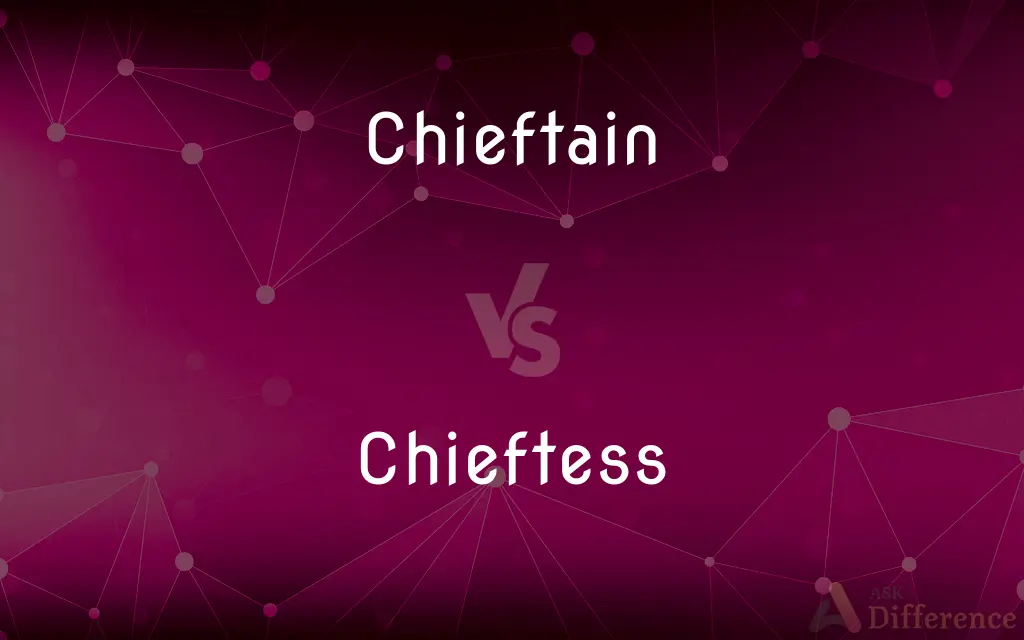Chieftain vs. Chieftess — What's the Difference?
Edited by Tayyaba Rehman — By Maham Liaqat — Updated on April 26, 2024
A chieftain is a male leader or ruler of a tribe or clan, noted for his authority and control, while a chieftess refers to a female counterpart who holds similar leadership roles.

Difference Between Chieftain and Chieftess
Table of Contents
ADVERTISEMENT
Key Differences
A chieftain traditionally refers to a male leader of a tribe or clan, who exercises authority over a community and is involved in decision-making and governance. On the other hand, a chieftess is the female equivalent, holding leadership roles and responsibilities within her tribe or clan, often with similar powers and duties as her male counterparts.
Chieftains are often seen as the primary figures in cultural narratives, embodying the traditional roles of leadership and power within tribal societies. Whereas chieftesses, although sometimes less highlighted in historical texts, also command respect and authority, often playing crucial roles in the social and spiritual life of their communities.
In many cultures, the role of a chieftain is hereditary or elected by the tribe, with the leader being responsible for the welfare and protection of their people. Conversely, chieftesses may also inherit or be elected to their positions, with a focus not only on governance but also on preserving cultural heritage and managing domestic and communal affairs.
Chieftains typically engage in negotiations, warfare, and alliances with other tribes or external entities to secure their tribe's interests. On the other hand, chieftesses might also participate in or lead these activities, though in some cultures, their roles could be more centered around peace-making and internal community management.
Both chieftains and chieftesses are integral to the cultural and social structures of their communities, with their roles often steeped in tradition and ritual. However, the visibility and recognition of chieftesses can vary significantly across different societies and historical periods.
ADVERTISEMENT
Comparison Chart
Definition
Male leader of a tribe or clan
Female leader of a tribe or clan
Authority
High, involves governance and warfare
High, also involves governance, may focus more on peace-making
Cultural Role
Central, often highlighted
Important, but less often highlighted
Responsibilities
Decision-making, protection, negotiations
Decision-making, cultural preservation, possibly negotiations
Typical Influence
External and internal affairs
Often more focused on internal community affairs
Compare with Definitions
Chieftain
Holds authority over tribal affairs.
As a chieftain, his decisions affected the entire community.
Chieftess
Female leader or ruler of a tribe.
The chieftess was known for her wisdom and fairness.
Chieftain
Responsible for making strategic decisions.
The chieftain negotiated peace with neighboring tribes.
Chieftess
Can inherit or be elected.
She became chieftess after being chosen by her people.
Chieftain
Symbol of power and leadership.
The chieftain's presence commanded respect at all gatherings.
Chieftess
Balances governance with cultural duties.
The chieftess played a key role in preserving tribal traditions.
Chieftain
Male leader of a tribal society.
The chieftain led his people through both prosperous and tough times.
Chieftess
Equally authoritative in tribal leadership.
As chieftess, she held significant influence over the council.
Chieftain
Often a hereditary position.
He became chieftain following the traditions of his ancestors.
Chieftess
Often focuses on community and peace.
Her role as chieftess involved mediating conflicts within the tribe.
Chieftain
The leader or head of a group, especially of a clan or tribe.
Chieftess
Syn of chieftainess: a female chieftain.
Chieftain
A leader of a clan or tribe.
Chieftain
(by extension) A leader of a group.
The robber chieftain divided up the spoils.
Chieftain
A captain, leader, or commander; a chief; the head of a troop, army, or clan.
Chieftain
The leader of a group of people;
A captain of industry
Chieftain
The head of a tribe or clan
Common Curiosities
What is the primary function of a chieftain?
A chieftain's primary function is to govern and lead his tribe, often involving decision-making on warfare and alliances.
Can chieftesses engage in warfare like chieftains?
Yes, chieftesses can and do engage in warfare, though their roles may vary by cultural context.
What are the similarities between a chieftain and a chieftess?
Both hold leadership roles, wield authority, and have responsibilities for the welfare of their tribe.
What challenges do chieftesses face that chieftains might not?
Chieftesses might face gender-based biases that affect their authority and recognition.
How are the roles of chieftains and chieftesses perceived differently in society?
While both are leaders, chieftains are often more visible in historical and cultural narratives, whereas chieftesses' roles can be less emphasized but are equally important.
How does a chieftess come into power?
A chieftess may come into power through inheritance or election, similar to a chieftain.
How important is the role of a chieftess in tribal ceremonies?
Chieftesses often play crucial roles in ceremonies, especially those linked to cultural preservation.
What historical examples exist of chieftains or chieftesses?
Historical examples span many cultures, including Native American tribes and African clans.
Is the role of a chieftess recognized globally?
Recognition can vary significantly, but many cultures historically have positions akin to a chieftess.
Do chieftains and chieftesses always perform the same functions?
Functions can overlap, but there may be variations based on gender roles in specific cultures.
What impact do chieftains have on tribal law?
Chieftains often play a significant role in creating and enforcing tribal law.
What future changes are likely for the roles of chieftains and chieftesses?
The roles may evolve with societal changes, possibly leading to more equal visibility and recognition for chieftesses.
How does the community view a chieftain compared to a chieftess?
This varies by culture, but traditionally, both are respected, though the chieftain might be more publicly prominent.
What attributes are most valued in a chieftain and chieftess?
Leadership, wisdom, decisiveness, and the ability to maintain tribe stability and security are valued in both.
How does one become a chieftain or chieftess?
Typically through hereditary succession or community election.
Share Your Discovery

Previous Comparison
Divesture vs. Divestiture
Next Comparison
Petrolatum vs. PetroleumAuthor Spotlight
Written by
Maham LiaqatEdited by
Tayyaba RehmanTayyaba Rehman is a distinguished writer, currently serving as a primary contributor to askdifference.com. As a researcher in semantics and etymology, Tayyaba's passion for the complexity of languages and their distinctions has found a perfect home on the platform. Tayyaba delves into the intricacies of language, distinguishing between commonly confused words and phrases, thereby providing clarity for readers worldwide.














































